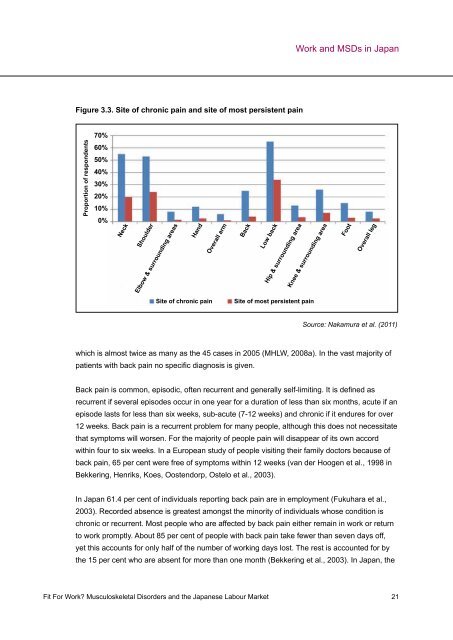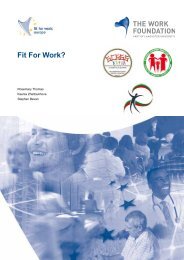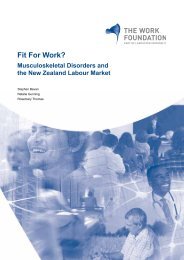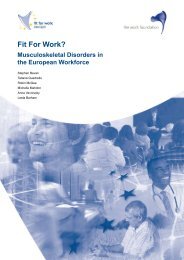English version - Fit for Work Europe
English version - Fit for Work Europe
English version - Fit for Work Europe
Create successful ePaper yourself
Turn your PDF publications into a flip-book with our unique Google optimized e-Paper software.
Figure 3.3. Site of chronic pain and site of most persistent pain<br />
Proportion of respondents<br />
70%<br />
60%<br />
50%<br />
40%<br />
30%<br />
20%<br />
10%<br />
0%<br />
Neck<br />
Shoulder<br />
Elbow & surrounding areas<br />
Hand<br />
Overall arm<br />
<strong>Work</strong> and MSDs in Japan<br />
which is almost twice as many as the 45 cases in 2005 (MHLW, 2008a). In the vast majority of<br />
patients with back pain no specific diagnosis is given.<br />
Back pain is common, episodic, often recurrent and generally self-limiting. It is defined as<br />
recurrent if several episodes occur in one year <strong>for</strong> a duration of less than six months, acute if an<br />
episode lasts <strong>for</strong> less than six weeks, sub-acute (7-12 weeks) and chronic if it endures <strong>for</strong> over<br />
12 weeks. Back pain is a recurrent problem <strong>for</strong> many people, although this does not necessitate<br />
that symptoms will worsen. For the majority of people pain will disappear of its own accord<br />
within four to six weeks. In a <strong>Europe</strong>an study of people visiting their family doctors because of<br />
back pain, 65 per cent were free of symptoms within 12 weeks (van der Hoogen et al., 1998 in<br />
Bekkering, Henriks, Koes, Oostendorp, Ostelo et al., 2003).<br />
In Japan 61.4 per cent of individuals reporting back pain are in employment (Fukuhara et al.,<br />
2003). Recorded absence is greatest amongst the minority of individuals whose condition is<br />
chronic or recurrent. Most people who are affected by back pain either remain in work or return<br />
to work promptly. About 85 per cent of people with back pain take fewer than seven days off,<br />
yet this accounts <strong>for</strong> only half of the number of working days lost. The rest is accounted <strong>for</strong> by<br />
the 15 per cent who are absent <strong>for</strong> more than one month (Bekkering et al., 2003). In Japan, the<br />
<strong>Fit</strong> For <strong>Work</strong>? Musculoskeletal Disorders and the Japanese Labour Market 21<br />
Back<br />
Low back<br />
Hip & surrounding area<br />
Knee & surrounding area<br />
Site of chronic pain Site of most persistent pain<br />
Foot<br />
Overall leg<br />
Source: Nakamura et al. (2011)







